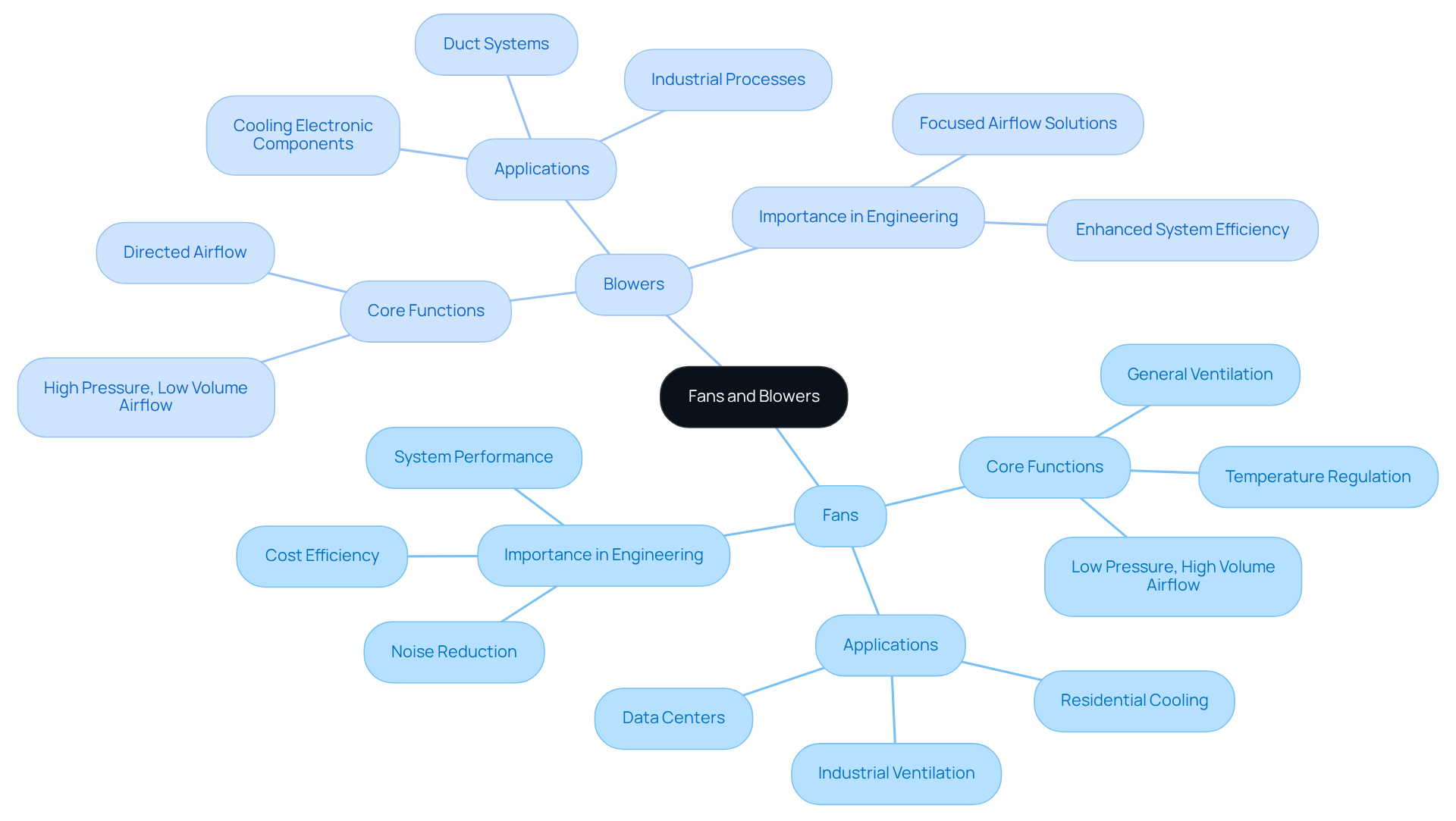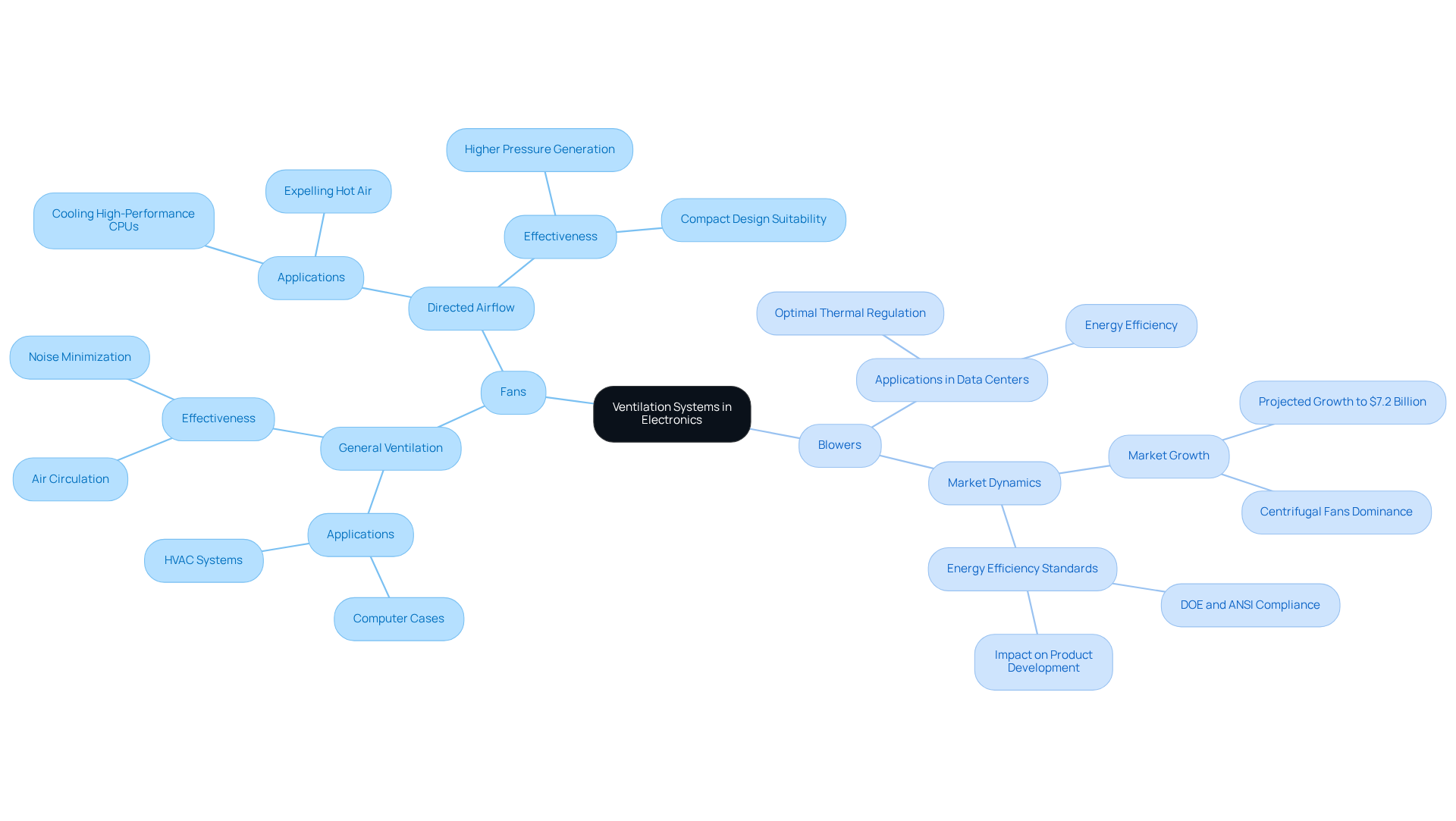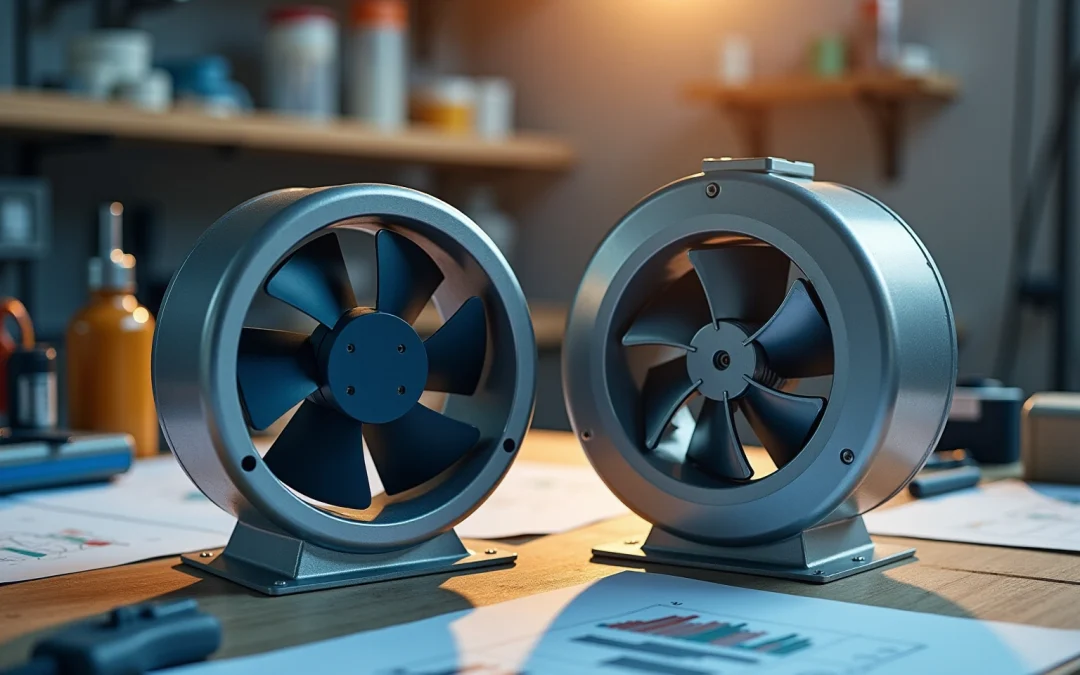Overview
This article examines the critical distinctions between cooling fan blowers and traditional fans, particularly in their functions and applications that are pertinent to engineers.
- Traditional fans are primarily designed for low-pressure, high-volume airflow, making them suitable for general ventilation.
- In contrast, cooling fan blowers generate higher pressure and directed airflow, which is essential for specific applications such as cooling electronic components in data centers.
This analysis underscores the significance of selecting the appropriate device based on specific airflow needs and pressure requirements, guiding engineers towards informed decisions in their projects.
Introduction
Understanding the intricacies of air movement is vital for engineers, particularly as the demand for efficient thermal management solutions continues to rise.
Cooling fan blowers and traditional fans serve distinct purposes, each playing a crucial role in various engineering applications, from data centers to automotive systems.
However, the challenge lies in discerning which device is best suited for specific needs. This raises an important question: how do engineers navigate the complexities of airflow and pressure to optimize performance in their designs?
Define Fans and Blowers: Core Functions and Mechanisms
Fans and ventilators are both essential mechanical devices for , yet they fulfill different roles and operate on distinct principles. A fan is primarily intended to move air within a designated area, producing low pressure and high volume airflow through spinning blades that generate a wide flow of air. This makes it suitable for general ventilation and temperature regulation. Conversely, a blower is designed to direct air in a specific manner, producing higher pressure and lower volume airflow. s utilize impellers to accelerate air, which makes them particularly effective in applications that require focused airflow, such as duct systems or cooling electronic components.
Comprehending these essential functions is crucial for engineers, particularly in the electronics sector, where the selection between a fan and an alternative device can greatly influence system performance. For instance, in data centers, the , while air movers are frequently employed to cool particular components, ensuring optimal operation. As the demand for effective refrigeration solutions escalates—especially in areas such as and — and pressure creation when choosing the suitable device for their purposes.
of both standard and custom air movers, providing a wide range of DC input tube axial devices, with sizes ranging from 15 to 280 mm, and centrifugal units, sized from 15 to 225 mm, optimized for performance, efficiency, and low noise. Their solutions cater to various industrial applications, including electronics and automotive fields, ensuring that engineers have access to advanced tailored to their specific requirements. Additionally, most models come with IP protection upon request, enhancing their adaptability for diverse environments. Based on market research, the worldwide sector is projected to expand at a CAGR of 5.7% from 2023 to 2031, underscoring the rising significance of these devices in various applications. Furthermore, engineers emphasize that the efficiency of cooling systems in critical environments, such as data centers, significantly relies on the appropriate use of cooling fan blowers and other ventilation devices. This highlights the necessity for engineers to remain informed about within the ventilation and air movement industry.

Compare Operational Principles: Fans vs. Blowers
The operational principles of air movers and blowers reveal distinct differences, particularly in airflow and pressure generation. Fans, such as those provided by Gagner-Toomey Associates, typically attain a . This capability allows them to efficiently move large volumes of air with minimal resistance, making them ideal for applications requiring general without significant pressure variations, such as HVAC systems or .
includes:
- DC input Tube Axial units, ranging from 15 to 280mm, designed for performance, efficiency, and minimal noise, with IP protection available upon request.
- Fans that boast an efficiency range of 60% to 80%, rendering them more energy-efficient for low-pressure applications.
In contrast, blowers operate at elevated pressure ratios, typically between 1.11 and 1.2, and can exceed 1.2 in specific scenarios. This enables them to generate a concentrated stream of air, which a provides, and is in ductwork or effectively cool densely packed electronic components, such as those found in data centers or industrial machinery.
Gagner-Toomey’s comprehensive collection of DC input , alongside EC devices ranging from 120 to 910mm, are engineered for exceptional performance in specialized situations, including exhaust systems and industrial ventilation. For example, the integration of blowers in medical imaging devices ensures effective heat dissipation, thereby enhancing the reliability of critical equipment.
Additionally, (VFDs) can significantly reduce electricity consumption for cooling fan blowers, making them an even more attractive option for engineers focused on efficiency. Understanding these distinctions is crucial for engineers when selecting the appropriate equipment for their specific applications.
Evaluate Applications: Choosing Between Fans and Blowers in Electronics
In , the decision between ventilation systems and air movers hinges on the specific requirements of the application. Fans are predominantly utilized for general ventilation tasks, such as in computer cases or HVAC systems, where the primary goal is to circulate substantial volumes of air to uphold comfortable temperatures. They are particularly effective in environments with ample space where minimizing noise is a critical consideration. Market forecasts indicate that the is projected to rise from $6.73 billion in 2024 to $7.2 billion in 2025, underscoring the escalating demand for efficient .
Conversely, fans are favored for applications necessitating , such as or GPUs within compact electronic housings. Their ability to generate higher pressure renders them ideal for or directing airflow through duct systems. Engineers must meticulously assess critical factors, including airflow requirements, spatial constraints, and noise levels, when determining the most suitable option for their projects. As Peter Friedrichs noted, “Our extensive range of SiC products illustrates the essential function of advanced materials in improving thermal management for electronic uses.”
The market dynamics further elucidate this distinction, with centrifugal fans and exhaust devices commanding significant shares in the electronics temperature regulation solutions sector, propelled by the increasing demand for . Practical applications, such as the employment of blowers in data centers for , further highlight the importance of making informed decisions in temperature management technologies. Effective maintenance practices can yield considerable benefits, with a projected annual of $226 following renovations, thereby showcasing the impact of selecting the appropriate cooling technology.

Conclusion
Understanding the differences between cooling fan blowers and traditional fans is crucial for engineers aiming to optimize air movement across various applications. While both devices facilitate air circulation, they operate on distinct principles and fulfill different roles. Fans are optimal for general ventilation, providing low-pressure, high-volume airflow, whereas blowers excel in delivering high-pressure, directed airflow essential for cooling specific components and overcoming resistance in duct systems.
Key insights reveal the operational principles that set fans apart from blowers, particularly regarding pressure ratios and airflow characteristics. The versatility of cooling fan blowers in electronics and industrial applications underscores their significance in maintaining optimal temperatures. Moreover, the article highlights the increasing market demand for efficient thermal management solutions, as evidenced by the projected growth in the fans and ventilation sector.
In light of these insights, engineers are urged to assess the specific requirements of their applications when choosing between fans and blowers. Making informed decisions based on factors such as airflow needs, space constraints, and noise levels is critical for enhancing system performance. As technology continues to advance, remaining informed about developments in cooling solutions is vital for achieving efficient and effective thermal management in engineering projects.
Frequently Asked Questions
What are the primary functions of fans and blowers?
Fans are designed to move air within a designated area, producing low pressure and high volume airflow for general ventilation and temperature regulation. Blowers, on the other hand, direct air in a specific manner, generating higher pressure and lower volume airflow, making them suitable for applications requiring focused airflow.
How do fans and blowers differ in their operation?
Fans operate with spinning blades to create a wide flow of air, while blowers utilize impellers to accelerate air, allowing for more directed airflow.
In what applications are cooling fan blowers particularly effective?
Cooling fan blowers are effective in duct systems and for cooling electronic components, as they provide focused airflow necessary for these applications.
Why is it important for engineers to understand the differences between fans and blowers?
Understanding the differences is crucial for engineers, particularly in the electronics sector, as the choice between a fan and a blower can significantly impact system performance, especially in environments like data centers.
What role do cooling fan blowers play in data centers?
Cooling fan blowers are vital for regulating ambient temperatures in data centers, ensuring optimal operation of the equipment.
What is the significance of Gagner-Toomey Associates in the air movement industry?
Gagner-Toomey Associates is the largest producer of both standard and custom air movers, offering a wide range of devices optimized for performance, efficiency, and low noise for various industrial applications.
What is the projected growth rate for the worldwide ventilation and exhaust systems sector?
The sector is projected to expand at a CAGR of 5.7% from 2023 to 2031.
How do engineers ensure the efficiency of cooling systems in critical environments?
Engineers emphasize the appropriate use of cooling fan blowers and other ventilation devices to maintain the efficiency of cooling systems in critical environments like data centers.
What additional features do many air mover models offer?
Many models come with IP protection upon request, enhancing their adaptability for diverse environments.

